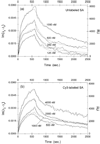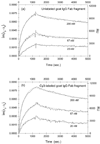Effect of fluorescently labeling protein probes on kinetics of protein-ligand reactions
- PMID: 18991423
- PMCID: PMC2721158
- DOI: 10.1021/la802097z
Effect of fluorescently labeling protein probes on kinetics of protein-ligand reactions
Abstract
We studied the effect of fluorescently labeling proteins on protein-ligand reactions. Unlabeled ligands (streptavidin-binding peptides and rabbit immunoglobulin G (IgG) as antigen targets) are immobilized on epoxy-functionalized glass slides. Unlabeled and Cy3-labeled protein probes from the same batch (streptavidin and goat antibodies) subsequently react with the surface-immobilized targets. By monitoring in situ the surface mass density change using an oblique-incidence reflectivity difference scanning microscope (a label-free detector), we measured k(on) and k(off) for streptavidin-peptide reactions and antibody-antigen reaction. We found that (1) equilibrium dissociation constants, defined as K(D) = k(off)/k(on), for streptavidin-peptide reactions increases by a factor of 3-4 when the solution-phase streptavidin is labeled with Cy3 dye and (2) K(D) for reactions of solution-phase goat anti-rabbit antibodies with rabbit IgG targets also change significantly when the goat antibodies are labeled with Cy3 dye.
Figures






References
-
- Schena M. Microarray Analysis. Hoboken: John Wiley and Sons; 2003.
-
- Zhu H, Bilgin M, Bangham R, Hall D, Casamayor A, Bertone P, Lan N, Jansen R, Bidlingmaier S, Moufek T, Mitchell T, Miller P, Dean RA, Gerstein M, Snyder M. Science. 2001;293:2101–2105. - PubMed
-
- MacBeath G. Nature Genet. 2002;32:526–532. - PubMed
-
- Kodadek T. Chem. Biol. 2001;8:105–115. - PubMed
-
- Quake S. private communication
Publication types
MeSH terms
Substances
Grants and funding
LinkOut - more resources
Full Text Sources
Other Literature Sources

